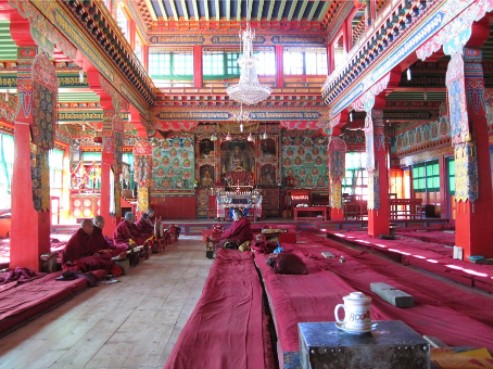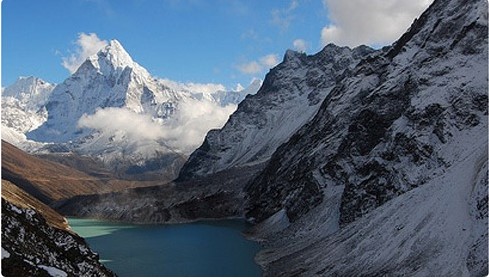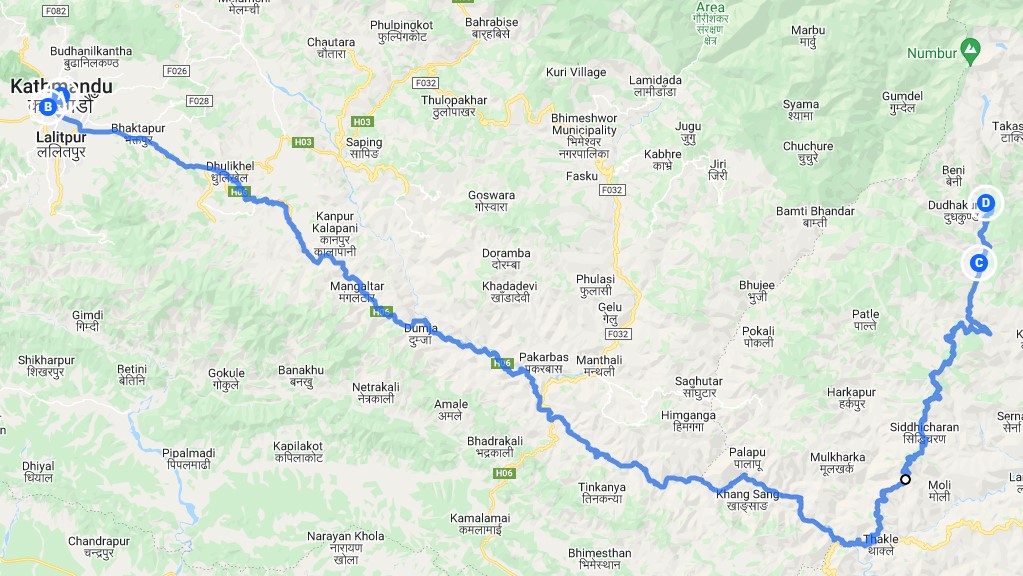
This 15-day trek offers breathtaking views of Mount Everest and the Himalayan Range while taking you off the beaten path. You’ll learn about authentic Sherpa culture and visit the sacred lake of Dudh Kunda.
Highlights
- Ascend Pikey Peak, one of Nepal’s best viewpoints.
- Enjoy breathtaking views of Mt. Kanchenjunga and the Annapurnas.
- Visit the ‘Dudh Kunda’ lake, which is sacred to both Buddhists and Hindus.
- Camping in the wilderness should be combined with nights spent in local tea houses.
- Experience genuine Sherpa hospitality in authentic villages along the way.
- Visit the Thubten Choling and Chiwong monasteries to learn about Himalayan Buddhism.
Overview
This 13-day trek takes you off the beaten path to discover lesser-known villages and wilder areas of the lower Everest region. You combine nights spent in local tea houses at lower elevations with wilderness camping as you travel far off the beaten path to visit the sacred ‘Dudh Kunda’ lake.
Your journey takes you through authentic Sherpa villages where you will stay with local hosts, through stunning forests where you will have a good chance of seeing wildlife, and up into the breathtaking Himalayan landscape surrounding the sacred lake.
Your trek begins with a short flight to Phaplu, from which you ascend to Pikey Peak, possibly Nepal’s best Himalayan viewpoint. On a clear day, you can see from Mt. Kanchenjunga to the Annapurnas in the east to the Annapurnas in the west! And, of course, Mt. Everest is front and center.
Trek down from Pikey Peak to the large Sherpa village of Junbesi, where you can visit the Thubten Choling Monastery, which served as the first point of contact for many Tibetan refugees and is still home to a sizable Tibetan Buddhist population. On the camping portion of your trek, you continue upwards to Dudh Kunda and return to Phaplu via Chiwong Gompa (monastery).
Want to know more?
| Viber / WhatsApp | 9864014537 |
| Kathmandu office | 01-4439962, 01-4439963 |
| Price | Rs. *per person |
Trip Itinerary Brief
| Day | Highlights | Overnight |
| Day 1 | Welcome to Kathmandu | Kathmandu |
| Day 2 | Explore to Kathmandu | Kathmandu |
| Day 3 | Fly to Phaplu, Drive to Dhap, Trek to Japre | Japre |
| Day 4 | Trek to Pike Base Camp | Pike Base Camp |
| Day 5 | Trek to Pikey Peak and down to Taktor | Taktor |
| Day 6 | Trek to Junbesi and explore the monasteries and town | Junbesi |
| Day 7 | Visit Thubten Choling monastery, camping | Thubten Choling monastery day day |
| Day 8 | Trek to Yak Kharka or nearest, camping | Yak Kharka |
| Day 9 | Trek to Saharsa Beni, camping | Saharsa Beni |
| Day 10 | Trek to Dudh Kunda, camping | Dudh Kunda |
| Day 11 | At Dudh Kunda, camping | Dudh Kunda |
| Day 12 | Trek to Timba or nearest, camping | Timba |
| Day 13 | Trek to Taksindu | Taksindu |
| Day 14 | Trek to Phaplu, optional visit to Chiwong Gompa | Phaplu |
| Day 15 | Fly to Kathmandu; Depart |
Itinerary in Detail
Day 1: Welcome to Kathmandu and prepare for the trek

As you fly into Kathmandu, you’ll be treated to stunning views of the valley, the Himalayas, and the terraced fields below. After clearing customs, a representative will be waiting to help you navigate the narrow, winding streets of Kathmandu and get you settled into your hotel. After you’ve settled in, go see one of Kathmandu’s cultural highlights. In the evening, the tourist district of Thamel is a good place to get your first meal, with a variety of restaurants serving both Western and Nepali cuisine.
Day 2: Explore Kathmandu

Kathmandu has a unique atmosphere in the early morning hours, when the city is slowly awakening but not becoming too chaotic. It’s a great time to go for a walk and explore the streets, or to enjoy a chai while looking out over one of the local courtyards or durbar squares. Given the many incredible sights in the Kathmandu Valley, there are numerous ways to spend the day. Later in the evening, go out to one of the city’s great restaurants for dinner, or your specialist can arrange a home-cooked dinner with a local family.
Day 3: Fly to Phaplu, drive to Dhap, trek to Japre

After a short flight to the small airstrip at Phaplu, you can take a jeep to the ridgeline to the south at Dhap, where you will begin your trek. As you get closer to Sigane, you’ll notice mountains that you’ll get to know well on this trek. These are the peaks of the Himalayan Range’s Numbur Himal section.
For the first couple of hours, the trail from Sigane follows a road that is currently under construction. The first village, Japre (2920m), is perched above a deep valley with stunning views of Everest and the Numbur Himal. There’s a lovely little Gompa and Stupa here, and you stay at a village tea house.
Day 4: Trek to Pikey Base Camp
The trail from Japre ascends to a grassy ridge at Bhulbhule. There is one unnamed lodge here with great views of the Everest range. The trail splits shortly after Bhulbhule, and you should take the right fork up to Pikey Peak. Before contouring around the hillside below Taklung Danda, your path passes some old yak herders’ houses and a long ‘Mani Stone‘ wall (ridge). You continue along a lovely forested trail lined with Rhododendrons for about 2 hours until you reach Pikey Peak base camp.
At 3,640 m, there’s only one lodge, with some (draughty) rooms in a separate building, but you might be able to hang out in the dining room. The summit at 4,065 m is a short climb, but unless it’s an unusually clear evening, it’s best to go to bed early and save the climb for sunrise.
Day 5: Trek to Pikey Peak and down to Taktor
The trail to the summit of Pikey Peak begins behind the lodge and follows a gradual slope strewn with prayer flags to the summit. It is critical to begin before dawn to reach the top in time for sunrise, as the views from the top are breathtaking. If the weather is clear, you will be rewarded with breathtaking views stretching from Annapurna to Kanchenjunga.
You descend a ridgeline from the summit of Pikey to Jase Bhanjyang, where a good crew will have breakfast ready for you. You have a few options for your descent to Junbesi after leaving Jase Bhanjyang, but we highly recommend the stunning “Shortcut trail,” which leaves the ridge shortly after Jase and descends steeply through spectacular old-growth forest to Taktor (at approximately 3,007 m).
Here you meet the Everest Base Camp trail coming from Jiri, which means the tea houses are a little more developed and you might meet a few other trekkers.
Day 6: Trek to Junbesi and explore the village
Junbesi (2,675 m), a traditional Sherpa village considered a cradle of Sherpa culture and architecture, is a couple of hours’ walk from Taktor on a beautiful trail. The Solu Khumbu is considered a ‘Beyul’ or sacred valley by the Sherpas, and there are numerous Buddhist monasteries. Buddhism survives with deep faith and resonance in this remote region of Nepal bordering Tibet. Junbesi is a large village with a variety of relaxing tea houses.
Day 7: Visit Thubten Choling Monastery and camp farther up the valley

This morning, you follow the river as it meanders through fields and flowers towards Thupten Choling, a very special place where 800 monks live in tiny cottages dotting the hill behind the main Gompa. After fleeing Tibet, His Holiness the late Trulsik Rinpoche founded the monastery in the 1960s. Thupten Choling provides housing, food, and education to a large population, the majority of whom are Tibetan refugees. This is one of the first points of contact for the many Tibetans who arrive in Nepal each year. Although the majority of refugees continue to India, approximately 40 nuns per year remain and join the monastery.
From here, you continue up the valley for another hour to your first campsite, where you are joined for the first time by the entire camping crew. You will now spend each night camping until you reach Taksindu.
Day 8: Trek to Yak Kharka
Because you will be ascending steadily over the next few days, you must pay attention to how your body is acclimating. Your visit to Pikey Peak earlier in the trek has greatly aided your acclimatization; however, keep an eye out for any early signs of altitude sickness and drink plenty of water. Today’s journey takes you through a magical forest and up to a pass near where you’ll spend the night.
Day 9: Trek to Saharsa Beni
Over the next two days, you will follow a ridge that will bring you closer to the snow-capped peaks of the Rowaling Himal. It’s difficult to believe, but this lonely trail is teeming with pilgrims during the festival season! You will almost certainly have the entire landscape to yourself and will camp in meadows surrounded by rock faces and yak grazing.
Day 10: Trek to Dudh Kunda

Dudh Kunda Lake (4560m), located at the foot of Mt. Numbur and the Karyalung Glacier, is thought to be Lord Shiva’s abode. Pilgrims flock to the lake during the full moon in August because Buddhist and Hindu devotees believe that a dip in the icy lake will wash away their sins. It only takes a couple of hours to walk from your last camp, and you can spend the rest of the day relaxing in this breathtaking location.
Day 11: At Dudh Kunda
Today is a day to rest and/or explore this incredible location. This is the high point of your journey, so take your time here to truly appreciate the beauty of this location.
Day 12: Trek to Timba
After a morning Kora (lake circumambulation), you retrace our steps to Thadarbug and rejoin the traditional pilgrim route to Taksindu La. You follow the ridgeline south, stopping at one of the herder’s camps along the way.
Day 13: Trek to Taksindu
This morning, you will continue down the ridgeline towards the main Jiri to Everest trail at Taksindu La, from which you will have great mountain views once again. After a short descent, you will arrive at Taksindu Monastery and the village, where you can stay in a local tea house.
Day 14: Trek to Phaplu, optional visit to Chiwong

Today you leave the main trekking route and follow a beautiful forest path down to Phaplu. Hike up to Chiwong Gompa, which is perched high on a cliff overlooking the valley. This monastery was founded in 1923 and hosts magnificent autumn celebrations for the Mani Rimdu festival. You continue down into Phaplu, where you celebrate the end of a fantastic trek in your cozy tea house in the village.
Day 15: Fly to Kathmandu

Today you bid farewell to the mountains and fly back into Kathmandu Valley. Enjoy your final moments in Kathmandu with breakfast in a cafe, a city stroll, and/or souvenir shopping. A representative will meet you at your hotel and drive you to the airport for your return flight home. It’s best to arrive at the airport at least two hours before your flight.
Variations
If you have more time, you can trek across to and fly out of Lukla, which is the starting point for the popular Everest Base Camp trek (another fortnight if you have the time for it). You can also enter or exit through Jiri, which was the start of the historic trek route before flights became an option.
If you have less time, you can cut the number of days by skipping the rest/exploration day at Dudh Khuda. It is also possible to trek to Dudh Kunda without visiting Pikey Peak, though we strongly advise against it!
Best season to Trek
This area receives a lot of rain during the monsoon season, so we don’t recommend doing this trek during that time. Trekking is best done during the extended Spring season (mid-February to May) or in the Autumn (October to mid-December). Winter is bitterly cold, but the skies are generally blue and the views are breathtaking. The Rhododendrons will bloom in the spring, usually around March, and this should be factored into your travel plans because the forests are truly stunning when in bloom.
Getting there & away
A short flight from Kathmandu will take you to the tiny Phaplu airport. It’s a good idea to plan some extra days at the end of your journey in case bad weather delays your flights, which is a fairly common occurrence in Phaplu. It is also possible to drive in, though this takes an extra day and is quite a rough drive near the end. Buffer days can be spent exploring the fascinating Kathmandu Valley, getting a well-deserved massage, and eating the amazing food that Kathmandu has to offer.
Difficulties
This is an extremely remote, non-touristy, and uncrowded trek. Don’t expect a luxurious lodge. During your trek, you will walk through the jungle (forest) and pastureland, in the lap of mountains, and on the summits of peaks. You spend the night in a tent. You walk up to 4560 meters. It implies that you must be physically strong in order to walk. It is not possible for solo travelers or lodge expected trekkers, but in groups for camping trek, it can be the best trek travelers who are nature and culture enthusiasts. You create lasting memories.
Map

